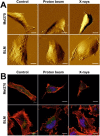Increased elasticity of melanoma cells after low-LET proton beam due to actin cytoskeleton rearrangements
- PMID: 31065009
- PMCID: PMC6504917
- DOI: 10.1038/s41598-019-43453-7
Increased elasticity of melanoma cells after low-LET proton beam due to actin cytoskeleton rearrangements
Abstract
Cellular response to non-lethal radiation stress include perturbations in DNA repair, angiogenesis, migration, and adhesion, among others. Low-LET proton beam radiation has been shown to induce somewhat different biological response than photon radiation. For example, we have shown that non-lethal doses of proton beam radiation inhibited migration of cells and that this effect persisted long-term. Here, we have examined cellular elasticity and actin cytoskeleton organization in BLM cutaneous melanoma and Mel270 uveal melanoma cells. Proton beam radiation increased cellular elasticity to a greater extent than X-rays and both types of radiation induced changes in actin cytoskeleton organization. Vimentin level increased in BLM cells after both types of radiation. Our data show that cell elasticity increased substantially after low-LET proton beam and persisted long after radiation. This may have significant consequences for the migratory properties of melanoma cells, as well as for the cell susceptibility to therapy.
Conflict of interest statement
The authors declare no competing interests.
Figures







Similar articles
-
Proton beam irradiation inhibits the migration of melanoma cells.PLoS One. 2017 Oct 10;12(10):e0186002. doi: 10.1371/journal.pone.0186002. eCollection 2017. PLoS One. 2017. PMID: 29016654 Free PMC article.
-
Proteomic analysis of proton beam irradiated human melanoma cells.PLoS One. 2014 Jan 2;9(1):e84621. doi: 10.1371/journal.pone.0084621. eCollection 2014. PLoS One. 2014. PMID: 24392146 Free PMC article.
-
Let-7b overexpression leads to increased radiosensitivity of uveal melanoma cells.Melanoma Res. 2015 Apr;25(2):119-26. doi: 10.1097/CMR.0000000000000140. Melanoma Res. 2015. PMID: 25588203
-
Proton therapy for the management of uveal melanoma and other ocular tumors.Chin Clin Oncol. 2016 Aug;5(4):50. doi: 10.21037/cco.2016.07.06. Chin Clin Oncol. 2016. PMID: 27558251 Review.
-
Treatment of uveal melanoma by accelerated proton beam.Dev Ophthalmol. 2012;49:41-57. doi: 10.1159/000328257. Epub 2011 Oct 21. Dev Ophthalmol. 2012. PMID: 22042012 Review.
Cited by
-
Inhibition of ATM Increases the Radiosensitivity of Uveal Melanoma Cells to Photons and Protons.Cancers (Basel). 2020 May 28;12(6):1388. doi: 10.3390/cancers12061388. Cancers (Basel). 2020. PMID: 32481544 Free PMC article.
-
Proton boron capture therapy (PBCT) induces cell death and mitophagy in a heterotopic glioblastoma model.Commun Biol. 2023 Apr 8;6(1):388. doi: 10.1038/s42003-023-04770-w. Commun Biol. 2023. PMID: 37031346 Free PMC article.
-
Involvement of extracellular vesicles in the progression, diagnosis, treatment, and prevention of whole-body ionizing radiation-induced immune dysfunction.Front Immunol. 2023 Jun 15;14:1188830. doi: 10.3389/fimmu.2023.1188830. eCollection 2023. Front Immunol. 2023. PMID: 37404812 Free PMC article.
-
The Impact of Deep Local Lung Hyperthermia on COVID-19 Cancer Patients.Adv Biomed Res. 2024 Oct 28;13:92. doi: 10.4103/abr.abr_75_23. eCollection 2024. Adv Biomed Res. 2024. PMID: 39717255 Free PMC article.
-
Imaging Mass Spectrometry-Based Proteomic Analysis to Differentiate Melanocytic Nevi and Malignant Melanoma.Cancers (Basel). 2021 Jun 26;13(13):3197. doi: 10.3390/cancers13133197. Cancers (Basel). 2021. PMID: 34206844 Free PMC article.
References
-
- Gragoudas ES. The Bragg Peak of proton Beams for Treatment of Uveal melanoma. Int. Ophthalmol. Clin. 1980;20:123–133. - PubMed
-
- Collaborative Ocular Melanoma Study Group The COMS randomized trial of iodine 125 brachytherapy for choroidal melanoma: V. Twelve-year mortality rates and prognostic factors: COMS report No. 28. Arch Ophthalmol. 2006;12:1684–93. - PubMed
Publication types
MeSH terms
Substances
LinkOut - more resources
Full Text Sources
Medical
Miscellaneous

